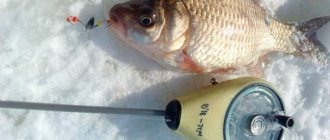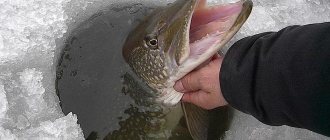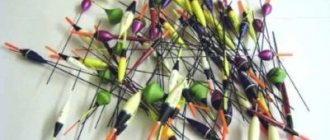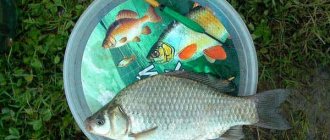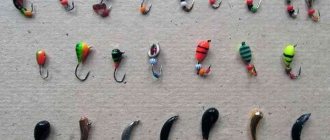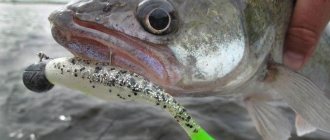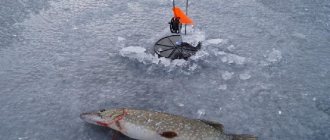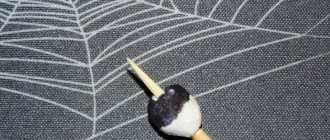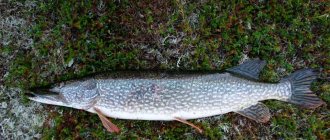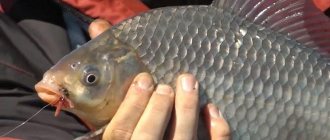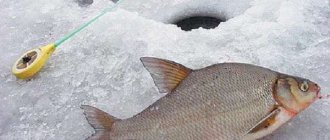The most common fish found in domestic reservoirs is crucian carp. It is found in large lakes, rivers, and small ponds. In addition, this fish can be found even in reservoirs in which other fish simply cannot survive due to a lack of oxygen in the water. To catch crucian carp, different methods and gear are used, for example, a rubber band or a feeder.
However, the most famous, popular and at the same time the simplest equipment that allows you to catch this underwater inhabitant is a float rod.
How to properly prepare the tackle
Float fishing rods are universal equipment. Such gear is suitable for catching different types of fish. In addition, they can be used quite successfully for fishing in a variety of bodies of water (lakes, rivers, ponds). However, to get a good result, especially when fishing for fish from the carp family, the float rod must be properly and correctly equipped.
First of all, when equipping a float fishing rod, you need to correctly select the hook for crucian carp. For successful fishing, it is preferable to select hooks with a straight ring eye. The tip of the hook should be bent inward, and the fore-end should be of a standard type. Thanks to this shape, the fish will not feel the presence of a hook on the bait when biting.
To catch crucian carp with a float, it is best to equip the rod with well-sharpened black hooks. The hook size is selected depending on the size of the bait used. In addition, when choosing hooks, you should take into account the size of the fish you are fishing for. Simply put, to catch large crucian carp and when using large massive baits, you need to use large hooks.
As a rule, float rods are equipped with inertial or inertial-free reels. At the same time, most experienced fishermen recommend using spinning reels when fishing for crucian carp with a float rod. To catch crucian carp, you can select floats of any color, since in this case the color schemes of this equipment have absolutely no effect on the fishing result.
For fishing in calm waters with a slight current, small floats weighing up to 5 grams are suitable. In addition, they are better suited in cases where crucian carp fishing is carried out in shallow water, near the coastline. If you plan to catch this fish far from the coastline using long casts, then it is better to equip the fishing rod with large floats with bright colors, which will be easy to see from afar.
Expert advice
Forester Seva
Expert
Ask a Question
Ideally, crucian carp should be caught with the lightest possible equipment, and the lighter it is, the thinner the line should be in order to cast the tackle. Therefore, I recommend using the most delicate equipment if the target fish is crucian carp and bites, for example, from carp, are not expected. However, if you know that there is carp in the reservoir and it can periodically bite, then the equipment should be made more reliable, sacrificing lightness.
To equip a float fishing rod, as a rule, monofilament fishing line is used. The diameter of the fishing line depends on the size of the fish being fished. For example, for catching small crucian carp weighing up to 100 grams, a 0.1 mm fishing line is perfect. If fishing is carried out on large individuals weighing more than 800 grams (up to 1 kg), it is preferable to use a 0.14 mm fishing line (when fishing in reservoirs with strong currents, it is recommended to use a 0.16 mm fishing line).
For fishing in unknown, unexplored waters, where the average weight of crucian carp is unknown, it is better to prepare several fishing lines of different diameters for the gear, which can be replaced if necessary. A good, high-quality fishing line should have such qualities as elasticity and strength. In addition, it must be invisible to underwater inhabitants.
How and what to catch minnows with
The gudgeon is a fish that is not at all picky about bait. If it bites, it will bite equally on both maggots and bloodworms, although many sources recommend bloodworms as the best bait for gudgeon. I also agree that the gudgeon bites worse on plant and grain bait, but on animal bait, in my opinion, its bite is the same, and it doesn’t matter what’s on the hook - maggot, bloodworm or worm. Therefore, an ordinary dung worm will be enough for you to successfully catch this fish.
When fishing with a fishing rod, of course, it will not be relevant to use long rods; there are also no special requirements for the fishing line, since the gudgeon is not particularly careful, but of course it is better to take a thinner fishing line, the gudgeon will definitely not tear it, and a thinner fishing line will distract its attention from the bait smaller, a fishing line with a diameter no thicker than 0.15 mm is best. A gudgeon can cling to any hook, but it will be more difficult to hook it on a large one, so they usually use a small hook No. 3. In order to better see the bite of this small fish, it is better to choose a lighter float.
Personally, I caught minnows on a piece of fishing line with a hook tied to it, without any fishing rods or floats. The water was clear, and the bottom was sandy, clearly visible, on which schools of minnows were very clearly visible. I went into the water, the water was just above my knees or waist-deep, and looked out for minnows. Usually they were located on islands of sand between plants growing at the bottom. In these schools there were always several large minnows, and the rest were smaller. Seeing a gudgeon, I lowered the hook with a worm on it and almost immediately the fish grabbed my bait, naturally immediately hooked and went into the bag prepared for the catch. I could catch more than a hundred minnows while practically staying in place. The interest of such fishing is that you see the bite not through the float, but as the fish attacks your bait, trying to get ahead of its relatives and choosing the right moment to hook.
The best options for feeding crucian carp
Bait is used to lure fish directly to the fishing spot. The selected area on the reservoir is fed with bait right before catching crucian carp.
When making bait for crucian carp, as a rule, several different ingredients are used. However, it must be remembered that the bait made should be inferior in taste to the bait used when fishing for crucian carp. To lure crucian carp to the fishing site, the following baits are usually used:
- Chopped cereals.
- Boiled hemp grains.
- Cake, which is soaked in vegetable oil before use.
- Crushed, finely chopped dill and anise seeds, with the addition of garlic.
In addition, crucian carp actively reacts to bait made from crumbled honey gingerbread. It is worth noting that some fishermen actively use flavorings, as well as various additives, when making bait. However, in this case, flavorings should be used carefully, since their excessive use risks that the bait will scare away the fish rather than lure it to itself.
Read how to cook pearl barley for crucian carp and use it in fishing.
Homemade baits
You can make bait for catching crucian carp yourself at home. There are many different recipes that allow you to make catchy bait for this fish with your own hands, using available ingredients. For example, to prepare bait for crucian carp you need to take:
- sunflower cake (200 gr.);
- semolina (200 gr.);
- one kilogram of crushed wheat and barley;
- corn flour (200 gr.);
- corn grits (500 gr.);
- Corvalol (used as a flavoring agent).
Expert advice
Forester Seva
Expert
Ask a Question
You need to feed by making small balls of bait. At the same time, I recommend dividing the bait balls into three types according to the degree of their compression. Squeeze some of the balls as hard as possible, the second part moderately, and the third minimally, just so that they reach the catching point. Thus, the bait will work alternately at the bottom and constantly attract crucian carp.
To prepare the bait, you need to take all the above ingredients, mix them together and soak them in water (20 minutes). Then you need to add about 20 drops of Corvalol to the resulting mixture.
Porridge is an effective bait for attracting the attention of fish. They are perfect for catching crucian carp with a float rod in the summer. To make this porridge, you need to take peas and corn and chop them. It is best to pass the grains through a special crusher. Then the resulting substance must be sifted to form flour and cake.
At the next stage of preparation, the resulting cereal is brewed in boiling water. During fishing, in order to achieve the desired thickness, you can additionally add corn and pea flour to the porridge.
For fishing in early spring, you can make bait based on crushed seeds, barley groats and ground crackers. It is preferable to use dill seeds as flavoring agents.
The influence of the bottom when fishing for crucian carp
Crucian carp obtain food by digging into the mud and creating a large muddy cloud and leaving traces on the surface in the form of air bubbles. From them, experienced fishermen can determine the presence of fish, although it could also be tench, since it does the same. For this reason, crucian carp mainly live only in places where there is a muddy bottom. Rarely, it can be found in places with a hard bottom, but it enters such places by chance, or you can try to lure it there.
We recommend: Myths, misconceptions and truth about the water protection zone, is it possible to avoid a fine
It is useless to try to catch crucian carp in reservoirs with a sandy or rocky bottom.
Because of this feature, it is important to select the right baits and groundbaits so that they do not bury themselves in the silt under their own weight.
Baits and attachments for crucian carp
The taste preferences and behavior of crucian carp are influenced by many different factors. As a rule, the type of bait and attachment used to catch this underwater inhabitant should be selected taking into account factors such as weather conditions, water temperature, depth, and the amount of vegetation in the reservoir.
Baits for catching this fish can be of both animal and plant origin. In addition, recently, many fishermen have actively begun to use artificial baits, which also show a good level of catchability.
Plant attachment
Plant-type baits for catching crucian carp with a float rod are usually used during the summer season, when the water in the reservoir has had time to warm up. Various cereals serve as such attachments. In addition, dough can also be a catchable bait of plant origin, thanks to which you can catch crucian carp in the pond in the summer. The most popular plant-type baits that are used when fishing for crucian carp are:
- Semolina. To prepare this bait for crucian carp, you need to take semolina, fill it with water and put it in gauze. Then the resulting mixture must be placed in a container with boiling water. After cooking, the cooked semolina must be removed from the gauze and divided into small pieces.
- Pearl barley. This porridge just needs to be boiled in water, and then the boiled grains are placed on a hook. When cooking, pearl barley should not be overcooked, otherwise it will be problematic to bait it on hooks later.
- Wheat. It takes a long time to cook. To make such bait, you need to take wheat grains and soak them in water for 14 days. After this they can be placed on the hook.
- Porridge Hercules. Popular among fishermen. To prepare this attachment, you need to take a small amount of porridge and soak it in water. Then, right before use, in order to achieve the desired viscosity, dry porridge from the package should be added to the resulting substance.
In addition, plant-type bait such as dough for crucian carp, which allows you to catch large crucian carp using float tackle, is very popular. There are many different recipes for its preparation. Some fishermen, to increase the catchability of the bait, add ingredients such as honey and semolina to the dough. Natural flavors such as garlic and dill can be added to all herbal attachments.
Animal bait
Animal type baits are suitable for float fishing for large crucian carp. They are usually used in the cold season, at the beginning of spring or at the end of summer, when the water temperature in reservoirs begins to drop rapidly. The best animal baits for catching crucian carp are worms, maggots, and bloodworms. Unlike maggots and bloodworms, worms are much easier to get and put on a hook. In addition, during fishing, the worm begins to actively move on the hook, thereby attracting the attention and increased interest of underwater inhabitants and increasing the number of bites.
How to catch crucian carp
Usually crucian carp are caught on a float rod; if the goal is to catch large crucian carp, then light feeders or pickers are well suited for this purpose.
We recommend: How to put maggots on a hook
On the fishing rod
When fishing for crucian carp, there are many nuances when choosing a fishing rod. The most convenient and practical telescopic float rod. It must be strong and flexible. Fishing for crucian carp involves a constant search for fish, so the fishing rod must be mobile and quickly fold and assemble. The lighter the fishing rod, the more comfortable it is for the fisherman. The optimal rod length is 4-5 meters.
Crucian carp is a cautious and timid fish, often its bites are hardly noticeable. He should not feel any resistance that the bait and hook may provide. You should choose the thinnest fishing lines, examples of diameters are below in the table:
| Monofilament | 0.12 – 0.30 mm, depends on the specimens that live in the reservoir, respectively, the smaller the fish, the thinner the line, also if the bite is bad, it is better to use thinner lines, or try a braided line |
| Wicker | 0.08 mm |
Carp hooks are suitable for fishing; depending on the size of the fish, hooks of numbers 5-7 are used. The hooks must be very sharp.
The float is selected depending on the weather conditions, the current in the reservoir and the wind; it should not be bulky or heavy; the most convenient from personal experience is made from a porcupine feather or quill.
Crucian carp can be effectively caught using a sliding float.
On feeder and picker
Depending on the casting distance, you can use a feeder, or instead of a feeder, use a drop sinker and feed the bait manually.
Instead of feeder feeders, it is also effective to use homemade feeders made from plastic bottle caps.
Video from the channel.
Other fishing methods
Some catch crucian carp using special long plug rods, use rubber band fishing, and other methods, but they are all quite exotic and not for everyone.
Fishing for crucian carp with a float rod
A tackle such as a float rod allows you to catch fish in a reservoir at a depth of no more than 3 meters. As a rule, crucian carp lives almost at the very bottom of reservoirs, so to catch it you need to set the gear to a greater depth. To do this, the float must be installed at a decent distance from the hook.
Finding a fishing spot
Crucian carp is an unpretentious fish, so it can be found in almost all bodies of water. In addition, catching large crucian carp with a fishing rod is possible even in a small swamp or, for example, a ditch where there is water. In small lakes, as well as reservoirs that partially dry out in the summer, there is little food, so they are inhabited mainly by small-sized crucian carp.
In large lakes, as well as artificial reservoirs, you can catch large crucian carp. However, due to the presence of other species of underwater inhabitants and predatory fish, this will be more difficult to do than in small bodies of water. On small rivers, crucian carp should be looked for in shallow bays or higher up the current.
Technique for catching crucian carp with a float from the shore
When catching crucian carp with a float from the shore, it is best to use fly rods. To fish from the shore, you first need to arrange a place for gear. In order not to scare away the fish, you need to remain quiet and not come close to the water. It is better to throw bait to those places on the coastline or creeks where there is vegetation or snags. In stagnant reservoirs, fish need to be fed before catching. In this case, it is recommended to cast the bait as close to the reeds as possible.
Fishing for crucian carp in the reeds
Most often, crucian carp is found in places in the reservoir where vegetation is present. It can also often be found in reeds. This is due to the fact that the main food supply for this fish (flies, insects, mosquitoes) is located in the reed thickets. It is for this reason that reed thickets are the best place on a reservoir for catching crucian carp.
However, fishing in the thickets of this plant is not easy. Indeed, in this case, the fisherman must make his way through the reeds to clear, open water. In addition, if casts are unsuccessful, the line may become entangled in plants.
The technique of catching crucian carp with a float rod in the reeds involves the use of short rods. To do this, you can purchase a fly fishing rod, the length of which is no more than 3 meters. To make fishing more convenient, the reeds can be trimmed a little. The bait should be thrown as close as possible to the thickets of this plant. At the same time, when fishing for crucian carp in the reeds, the fishing depth set on the equipment practically does not affect the result, since in this place the fish are found everywhere.
How to choose the right place to catch crucian carp?
In summer, crucian carp tries not to appear in shallow water unnecessarily. It stands in the reeds, in deep (about 2 meters) holes. But “worth” does not mean “bites.” There he just rests.
It may pay attention to the bait, or it may ignore it. During those hours when it is not resting, the crucian carp slowly moves around the reservoir in search of food. Large crucian carp can easily overcome the current, but they don’t like it.
On rivers, there is a greater chance of finding this fish in bays and oxbow lakes, as well as in heavily overgrown areas of the reservoir with reeds at the border of open water and vegetation.
In early spring, large crucian carp can be caught on a weak current at the mouths of rivers flowing into a large body of water or in the straits between two bodies of water. The bait should be placed as close as possible to the border of aquatic vegetation and open water.
From late May to mid-September, large crucian carp can be caught in the following places:
Snag;
A hole 1 to 2 meters deep with or without a weak, circular current;
Boundary between open water and aquatic vegetation.
If all 3 factors coincide, then this place will be ideal for catching large crucian carp in a reservoir with a current.
In calm water reservoirs in the summer, when catching large crucian carp, you will have to show miracles of patience and attentiveness.
In most reservoirs in summer, this fish stays away from the shore and appears near coastal vegetation only in the early morning and late evening. But this is not an axiom.
In deep, weakly warmed reservoirs, large crucian carp can come to the shore in the middle of the day. And in some shallow reservoirs of calm water, crucian carp begin to feed only after sunset and approach the shore only at dusk.
Fishing for crucian carp in autumn. Behavior of crucian carp before winter
In autumn, large crucian carp go deeper, to places where the water still retains heat.
At this time, you can catch it near wintering pits all day long. Each body of water has its own behavioral characteristics of large crucian carp. In early spring, crucian carp can bite only in the middle of the day in all reservoirs.
Best time to catch crucian carp
In summer, crucian carp are most active in the early morning, as soon as the sun has risen and until 9–10 o’clock in the afternoon. In the evening, to catch it, you should go to the reservoir at 17.00, while the bite, depending on weather conditions, can last until dusk. At night, crucian carp becomes passive, so after sunset it will be difficult to catch. However, if there is summer heat and abnormal heat outside, then at night, when the water temperature drops slightly, it can actively attack bait.
About gudgeon
The gudgeon is a small fish that, strangely enough, belongs to the carp family. Occasionally it reaches a length of 20 cm. But usually its length does not exceed 10 cm. The gudgeon is easy to distinguish from other fish by its cylindrical body, back with a greenish tint, and along the silvery sides there are black, sometimes blue, spots. Along the edges of the mouth there is a pair of antennae. Sometimes the color of the gudgeon, depending on the reservoir, may differ, be darker or lighter.
Fishing for gudgeon, in addition to being simply interesting, is often associated with the fact that this fish is an excellent live bait and can be used as bait for any predatory fish. The gudgeon is especially to the taste of such predators as pike, pike perch and burbot. But, as I said above, any predator does not mind feasting on them.
What weather is best for fishing?
It is best to go fishing to catch crucian carp in warm, calm weather. In addition, this fish shows increased activity during a downpour with a thunderstorm, which begins after intense summer heat. This is due to the fact that raindrops, after falling into a reservoir, saturate the water with oxygen. However, immediately after a thunderstorm, the bite may stop for a short time.
Crucian carp exhibits high activity during prolonged cloudy weather, which is accompanied by light rains. When there are sudden changes in air temperature in the environment, trying to catch crucian carp with a float rod is almost useless. It is best to go fishing for crucian carp in the summer with a float rod during cloudy warm weather, when a weak north wind blows.
What is the best way to bite crucian carp?
Depending on the fishing season and weather conditions, the activity of crucian carp biting on certain baits and baits varies, so you always need to experiment during the fishing process, gradually selecting the best and most catchy ones.
However, it is worth noting the following baits, which almost always work well and crucian carp almost never remain indifferent to them.
Worms (it is better to use dung worms than earthworms) - we can confidently say that they are one of the best and very catchy baits for fishing for crucian carp, which perfectly attracts both small and larger individuals.
Steamed pearl barley is No. 2 in the ranking of the most catchy baits for crucian carp, which can also bring the fisherman a good catch, you just need to prepare it correctly so that it has an attractive aroma (you can add a little flour, vanillin or garlic juice).
Bites for pearl barley are generally quite active with the float completely sinking under the water (sometimes the crucian carp lays down or smoothly moves the float to the side).
It is best to put this attachment on a hook when catching large crucian carp, 2-3 pieces at a time, in order to hide the visible bare parts, which can greatly scare away the fish.
It is necessary to cook barley properly for 40-50 minutes, after which it should be rinsed well under running water (so that it does not stick together and is crumbly), then, if possible, it is recommended to add crushed seasonings for a good, attractive smell (vanillin, garlic juice, crushed black seeds, flour, etc.).
When fishing, it is recommended to gradually add steamed pearl barley, in small quantities, to the fishing spot so that the crucian carp constantly circles around it.
There are situations when fish practically do not bite on a worm or pearl barley, but are actively caught on semolina, so you need to always have it with you when fishing as a catchy and very attractive bait for crucian carp.
To cook it properly you need ½ tbsp. dilute semolina with a small amount of water, mix thoroughly until mushy, add a little flour, mix well again, the finished semolina should have a slightly thick consistency so that it sticks well to the hook.
You need to put it on the hook with a small wooden stick (since it has a slightly liquid state) twisting it around the hook in several small layers.
Fishing with semolina requires certain fishing skills, since when biting you need to hook the fish in time so that the bait is not quickly knocked off the hook, which is very common in fishing.
Bread with the addition of various aromatic spices often brings a good catch.
To prepare it, you need to add a little vanillin or flour to the crumb of black or white bread for an attractive smell, which fish almost always readily catches.
It is advisable to place small balls of bread on the hook. The bite usually begins with multiple twitching of the float with further sinking or a sharp lead to the side, in which you must always hook in time.
Quite often, crucian carp willingly bites on maggot , which is one of the very attractive baits.
The best time for fishing for crucian carp is early spring, summer and the entire first half of autumn, when the fish actively moves around the reservoir in search of prey.
Many amateur fishermen often use fresh dough as the main bait, which crucian carp readily bites on.
It’s not at all difficult to prepare, you just need to choose the right spices for it for a more attractive smell (painted flour, garlic juice, vanillin, breadcrumbs, etc.).
It is prepared like this: for 1 tbsp. flour, add a small amount of water until you obtain a mushy consistency, mix thoroughly, add aromatic spices (garlic juice, vanillin, flour, crushed black fried seeds) to quickly attract the attention of both large and smaller crucian carp.
All of the above baits and attachments for catching crucian carp work perfectly on any body of water, regardless of the fishing season.
